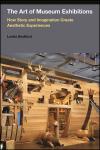What If?
Leslie Bedford’s book The Art of Museum Exhibitions continues to influence my thinking about exhibition development. Bedford succeeds in creating a new vocabulary to talk about exhibitions, one that avoids many of the pitfalls of discussing exhibits in purely education terms. Bedford uses the subjunctive mood, a Spanish verb tense, as a way of expressing a unique aspect of exhibitions–their ability to engage the imagination. Far too often exhibitions are discussed in terms of their limitations: They are not books on a wall (thank heavens). They are often not comprehensive in terms of subject matter. They are not especially successful in telling linear stories. Applying education terms to exhibitions has created false dichotomies such as the education versus entertainment argument that gave rise to the unfortunate term edutainment. Exhibitions are educational and they should be enjoyable, but they are more than these things. Exhibitions are unique three-dimensional environments that are experienced uniquely by each individual. As Bedford points out, they are more akin to theater than classroom.
Thinking about exhibitions in this way has shifted the way I approach their development. I now look at content through the lens the subjunctive mood–asking how it can engage the imagination–instead of judging the story it can tell. And speaking of storytelling, Bedford helps with vocabulary here too, reminding us that there is a difference between story (what happened) and narrative (how the story is told). We use narrative to make sense of things, integrating stories into our own experiences. Bedford quotes Chris Husbands, “The telling of stories calls forth further stories.” (Bedford, p. 59) and isn’t that one of the primary goals of an exhibition?
On her blog Museum Questions, Rebecca Herz examined the role of story in exhibitions, asking whether exhibitions should tell stories at all, pointing out that storytelling can overshadow other aspects of the experience. Rebecca and I had a great discussion about this on Museum Life, coming up with more questions than answers. Reflecting upon that discussion, I think that we could have gotten a better handle on our questions had we used Leslie Bedford’s vocabulary. In a good exhibition, story cannot stand alone, it must be examined within the context narrative and imagination. Perhaps the question is not whether stories have a place in exhibitions, but does the storytelling leave room for the visitor’s imagination?

